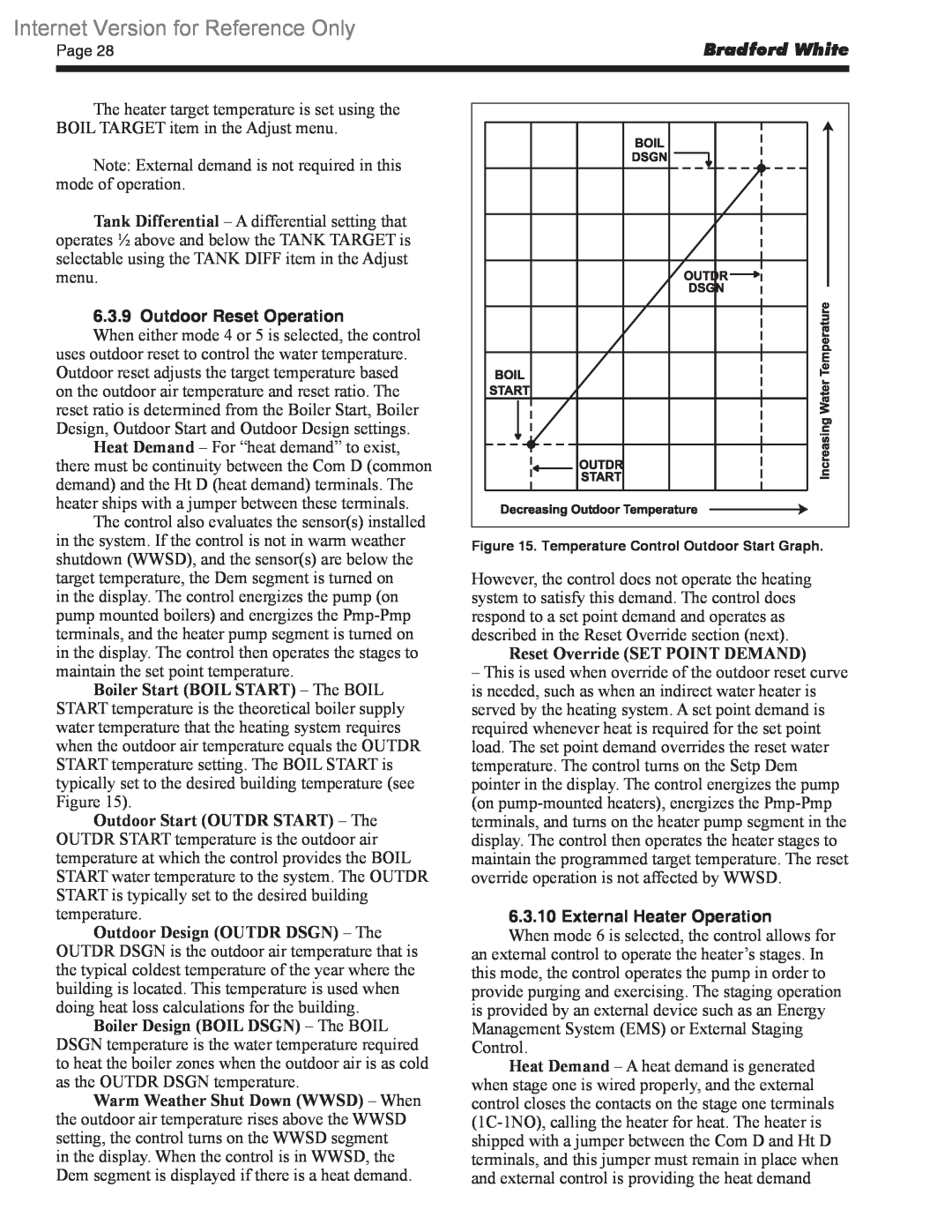
Internet Version for Reference Only
Page 28 | Bradford White |
|
|
|
|
The heater target temperature is set using the BOIL TARGET item in the Adjust menu.
Note: External demand is not required in this mode of operation.
Tank Differential – A differential setting that operates 1⁄2 above and below the TANK TARGET is selectable using the TANK DIFF item in the Adjust menu.
6.3.9 Outdoor Reset Operation
When either mode 4 or 5 is selected, the control uses outdoor reset to control the water temperature. Outdoor reset adjusts the target temperature based on the outdoor air temperature and reset ratio. The reset ratio is determined from the Boiler Start, Boiler Design, Outdoor Start and Outdoor Design settings.
Heat Demand – For “heat demand” to exist, there must be continuity between the Com D (common demand) and the Ht D (heat demand) terminals. The heater ships with a jumper between these terminals.
The control also evaluates the sensor(s) installed in the system. If the control is not in warm weather shutdown (WWSD), and the sensor(s) are below the target temperature, the Dem segment is turned on
in the display. The control energizes the pump (on pump mounted boilers) and energizes the
Boiler Start (BOIL START) – The BOIL START temperature is the theoretical boiler supply water temperature that the heating system requires when the outdoor air temperature equals the OUTDR START temperature setting. The BOIL START is typically set to the desired building temperature (see Figure 15).
Outdoor Start (OUTDR START) – The OUTDR START temperature is the outdoor air temperature at which the control provides the BOIL START water temperature to the system. The OUTDR START is typically set to the desired building temperature.
Outdoor Design (OUTDR DSGN) – The
OUTDR DSGN is the outdoor air temperature that is the typical coldest temperature of the year where the building is located. This temperature is used when doing heat loss calculations for the building.
Boiler Design (BOIL DSGN) – The BOIL DSGN temperature is the water temperature required to heat the boiler zones when the outdoor air is as cold as the OUTDR DSGN temperature.
Warm Weather Shut Down (WWSD) – When the outdoor air temperature rises above the WWSD setting, the control turns on the WWSD segment
in the display. When the control is in WWSD, the Dem segment is displayed if there is a heat demand.
Figure 15. Temperature Control Outdoor Start Graph.
However, the control does not operate the heating system to satisfy this demand. The control does respond to a set point demand and operates as described in the Reset Override section (next).
Reset Override (SET POINT DEMAND)
–This is used when override of the outdoor reset curve is needed, such as when an indirect water heater is served by the heating system. A set point demand is required whenever heat is required for the set point load. The set point demand overrides the reset water temperature. The control turns on the Setp Dem pointer in the display. The control energizes the pump (on
6.3.10 External Heater Operation
When mode 6 is selected, the control allows for an external control to operate the heater’s stages. In this mode, the control operates the pump in order to provide purging and exercising. The staging operation is provided by an external device such as an Energy Management System (EMS) or External Staging Control.
Heat Demand – A heat demand is generated when stage one is wired properly, and the external control closes the contacts on the stage one terminals
